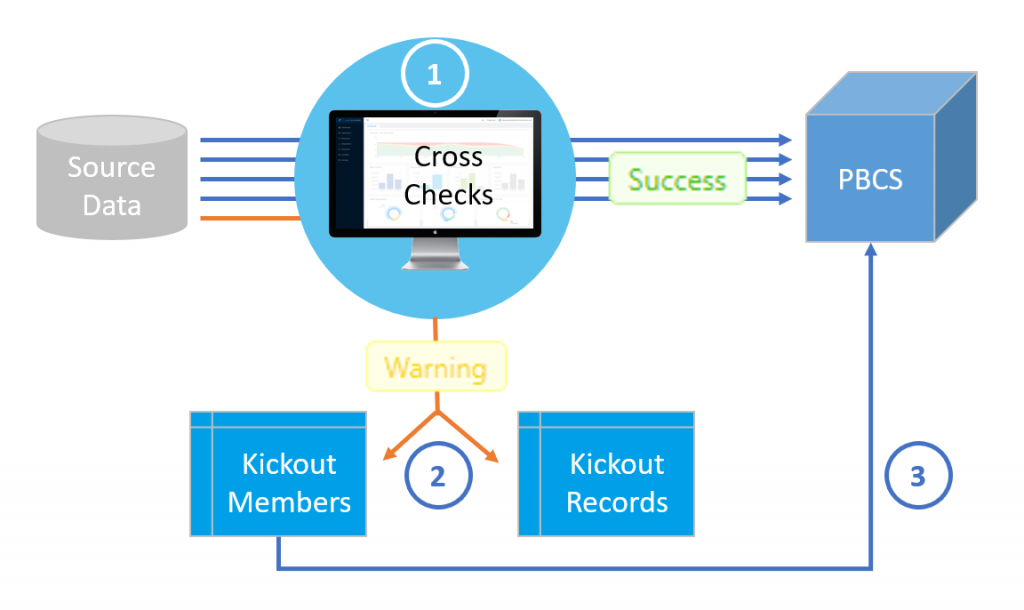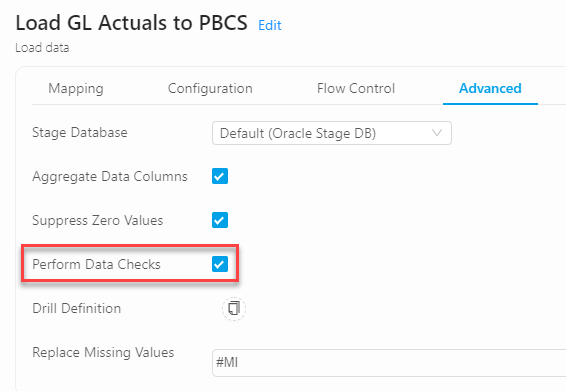If you have ever built a data load process for PBCS*, you will most likely have encountered a “kickout”. These data load errors result in a failed data load process. In many cases the action to resolve the error is adding the missing member to the target application as part of a manual process.
In this article we are going to look beyond the limitations of the common process flow for managing data with Data Management/FDMEE. Instead we are going to see an alternate way of managing kickouts with ICE Cloud. The built-in Application Intelligence (“AppIntel”) functionality can be activated by just checking a box. And the best thing is: ICE Cloud can automatically fix the data load errors as well!
* This also applies to any other EPM/Hyperion product, whether on-premise or in the cloud, like Essbase, HFM, Hyperion Planning, FCCS, EPBCS, ARCS, etc.
What is a “Kickout”?
Let’s make sure we are all talking about the same thing as some folks might use a different expression than kickouts.
A “Kickout” is a data load error which was caused by a missing member. When the source data includes data for a member that does not exist in the target application, it is not possible to load the data record which contains the invalid member. Data Management/FDMEE raises an error to inform the users/administrators that a data load problem occurred.
In this case an administrator needs to review the error log and search for the section which contains the information about any missing members. In this sections the invalid records are listed along with the name of the members which are causing the kickout. These data errors need to be resolved in order to load the entire dataset successfully.
The Common Process Flow with Data Management
If Data Management/FDMEE is used to load data to Oracle EPM applications, the process flow most often consists of the following steps:
- Prepare source data
Data needs to be imported into Data Management, for example from a flat file. A Location, Import Format and at least one Data Mapping for each dimension needs to be defined. - Attempt to load data to PBCS
In the background, a file is sent from Data Management to PBCS and PBCS attempts to load the data. The process will only be successful if each member of every records is valid and exists in PBCS. - Encounter a Kickout
When trying to load data and the database (i.e. Essbase) encounters a member in the data set which does not exist in the database, it throws an error and the data load fails. - Identify missing members
The administrator needs to investigate the log file to identify the reason for the error. If it is due to missing members, the admin needs to ensure that the missing member is valid and meant to be added to PBCS. - Add missing members
The administrators logs on to PBCS and manually adds the missing members. This manual task is an extra effort which delays the data load process. After adding the members to PBCS, the database needs to be refreshed. - Reload the data
After the members have been added and the administrator refreshes the database, the data load can be restarted. Hopefully this time all members are available. It is possible, however, that there are additional kickouts which have not been identified in the previous load. This can happen if a record contains more than one missing member, but Data Management returns an error for the first member in a record and does not consider any other errors in the data load. If there are additional errors, continue with step 4.

As you can see, this is a broken process with many manual steps. Even if you have an automation script in place, kickouts will always require attention from an administrator. Let’s look at an alternate way of managing kickouts so you can see an option that allows you to fully automate this process.
An Alternate Way of Managing Kickouts: ICE Cloud Data Checks
Are you ready to get rid of the manual steps involved in managing kickouts? Here is how you can do this: by leveraging ICE Cloud’s Data Checks which are built into the Application Intelligence (“AppIntel”) modules for all Oracle EPM products.
Step 1: Identify Kickouts in advance
Data Management identifies kickouts at the time when the data is loaded. ICE Cloud, on the other hand, performs a cross check of all members in the dataset and identifies any kickouts in advance.
Step 2: Separate Records with Invalid Members
ICE Cloud scans through the entire dataset you are trying to load to PBCS. It checks for every record if the members exist. If that is the case, then ICE Cloud passes the record along to be loaded to PBCS. If a record contains invalid members, however, ICE Cloud separates this record from the dataset and excludes it from the load to PBCS – as indicated by the orange arrow below. This way the “good” records will be loaded to PBCS without any hiccups and the “bad” records are put side to not cause any errors.
At the same time, ICE Cloud performs two additional actions:
- It generates a list of all kickout members. With this list, the administrator knows immediately which members are causing the kickouts. These can then be used in step 3 to automatically resolve the kickout problems.
- It writes all records with kickouts to a file. This file can be reviewed to gauge the impact of the kickouts and provide additional information – if needed.
Step 3: Add Kickout Member(s) to Dimension(s)
This is the best part of this process: ICE Cloud can automatically fix the data load errors by adding the kickouts on the fly. The kickout members which have been identified by ICE Cloud can easily be added to the PBCS application – automatically. Since ICE Cloud processes data and metadata, this is very easy to set up. We will cover metadata loads in a future post.

Step 4: Reload the data successfully
After the kickout members have been added to the PBCS application, the ICE Cloud process will immediately reload the data and this time it will be successful.
Configuring Data Checks in ICE Cloud
By looking at the data flow diagram above, this might seem like a complicated setup. But with ICE Cloud, this can be achieved with one click: all you have to do is check a single box and the entire process for capturing kickouts is implemented.
If you have seen our previous posts and videos, you might have noticed the checkbox which is labeled “Perform Data Checks”. Just check this box and ICE Cloud will automatically perform data checks on the entire dataset you are trying to load.
On any “Load data” task for Oracle EPM applications (like PBCS, FCCS, Essbase, etc.) this option is available and can be applied.

Sounds too easy? Schedule your free Proof of Concept to see for yourself how ICE Cloud helps you transform your processes – code-free and fully automated.
What’s next?
In our previous post, we reviewed a simple data load process which does NOT require Data Management and instead integrates data easily and seamlessly using ICE Cloud. In this post we have introduced ICE Cloud’s Data Check feature which simplifies managing kickouts which is one of the main hurdles to overcome when automating EPM processes. The next logical step will be adding the kickout members to PBCS as part of a fully automated process.
You can learn about managing metadata in our next article.
Do you have any questions? Are you ready to innovate? Schedule a demo or contact us with your questions today.
About ICE Cloud
ICE Cloud combines a user-friendly and intuitive interface with powerful integration and automation capabilities. This enables developers to build processes a lot faster and reduces the maintenance and troubleshooting effort by 50%.
Considering the need to agile planning process in uncertain times like these, finance innovators need the ability to quickly adapt to changing requirements. Creating repeatable processes which can be executed without hiccups are a key success factor. With ICE Cloud our customers accomplish this with ease and enable their teams to focus on value-add activities rather than troubleshooting errors.
Download the case study for InvenSense, a TDK group company, and learn how they integrated more than 25 data sources (including ADP, Oracle CX/Sales Cloud, Taleo, Oracle E-Business Suite GL and subledgers) and automated metadata of 8 dimensions in their EPBCS applications with the click of a button.
